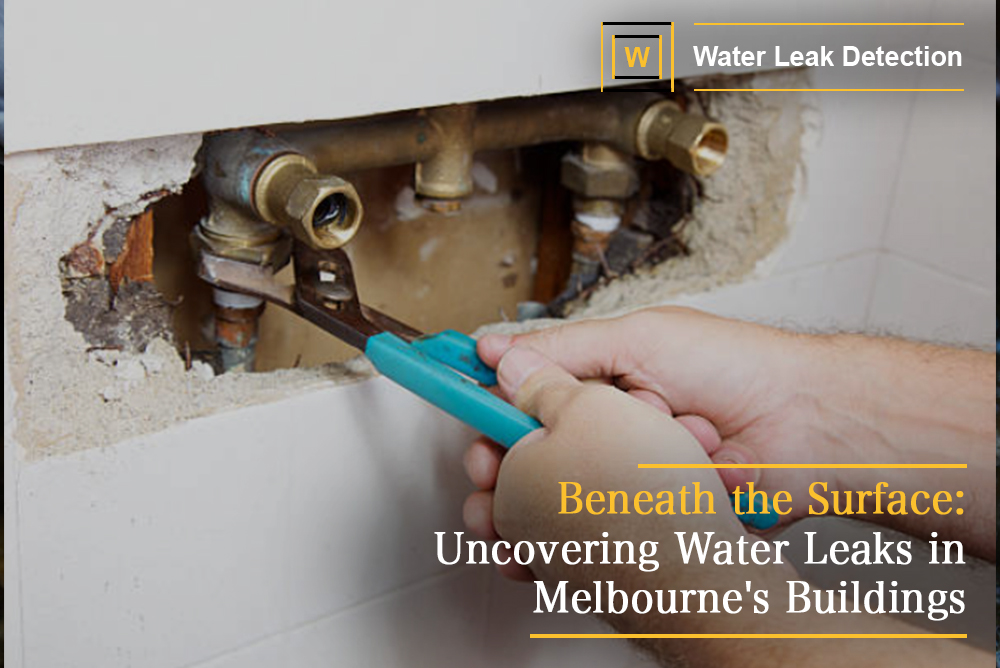
Water leaks within the structures of Melbourne’s buildings are akin to silent saboteurs, quietly undermining the integrity and safety of our spaces. The insidious nature of water leakage demands our vigilance and understanding to protect and preserve our urban habitats.
In today’s blog, we will take a look into the depths of water leak detection, mitigation, and prevention and offer a comprehensive guide to safeguarding our buildings against the unseen menace.
The Stealthy Nature of Water Leaks
Water leaks, often unnoticed until substantial damage has occurred, pose a significant threat to the structural integrity and safety of buildings. These covert infiltrators can lead to costly repairs and hazardous living conditions if not addressed promptly. Understanding the nuances of detecting and managing water leaks is crucial for building owners and residents alike.
The Importance of Early Detection
Early detection of water leaks is paramount in mitigating damage and minimizing repair costs. Recognising the early signs of leakage can prevent a minor issue from escalating into a major crisis. It’s about being proactive rather than reactive, a strategy that saves both time and resources in the long run.
Common Signs of Water Leaks in Buildings
Identifying the telltale signs of water leaks is the first step in tackling the issue. These signs may include damp patches on walls or ceilings, a sudden increase in water bills, musty odors, or the sound of running water when all taps are turned off. Being attuned to these indicators can aid in swift leak detection.
The Culprits: Where Water Leaks Often Originate
Water leaks can originate from various sources within a building, including but not limited to, damaged roofing, compromised piping systems, faulty plumbing fixtures, and foundation cracks. Understanding the common culprits behind water leaks is essential for targeted detection and repair efforts.
The Risks: Structural Damage and Health Hazards
The ramifications of unchecked water leaks extend beyond mere structural damage; they also pose significant health hazards. Persistent dampness can lead to the growth of mold and mildew, which are detrimental to respiratory health. Additionally, water intrusion can weaken building foundations, compromising the safety of occupants.
DIY Detection Methods: Tips and Tricks
While professional detection services are highly effective, there are DIY methods for identifying potential leaks. These include monitoring water usage for unexplained increases, using food coloring to detect toilet leaks, and visually inspecting piping for signs of corrosion or dampness.
Professional Leak Detection Techniques
Professional leak detectors employ advanced technologies, such as thermal imaging, acoustic sensors, and moisture meters, to accurately locate leaks without invasive measures. These techniques offer a non-destructive means of pinpointing leaks, ensuring that the integrity of the building is maintained during the detection process.
Mitigating Damage: Immediate Steps Post-Detection
Upon detecting a leak, immediate steps should be taken to mitigate damage. This includes shutting off the water supply to the affected area, removing water-logged items, and drying out damp areas. Quick action can significantly reduce the extent of damage and the potential for mold growth.
Repair and Restoration: Addressing the Aftermath
Repair and restoration efforts post-leak detection are crucial in restoring the building to its pre-leak condition. This may involve plumbing repairs, structural assessments, and mold remediation. Ensuring that repairs are carried out thoroughly and promptly can prevent recurrence and safeguard the building’s future.
Prevention: Best Practices to Avoid Future Leaks
Preventive measures are key to avoiding future water leaks. Regular maintenance checks, prompt repairs of minor leaks, and upgrades to plumbing systems can significantly reduce the risk of water damage. Educating residents and building managers on leak prevention practices is equally important.
Final Thoughts
The battle against water leaks in Melbourne’s buildings is an ongoing endeavor that requires vigilance, knowledge, and prompt action. By understanding the causes, signs, and solutions related to water leaks, we can protect our buildings from the clandestine dangers that lurk beneath the surface.
Let this be a call to action for all stakeholders to embrace the practices of detection, mitigation, and prevention, ensuring the longevity and safety of our urban environments.
If you suspect you have a water leak, please call us at Water Leak Detection for a free consultation today on 1300 425 325 or leave an inquiry.

